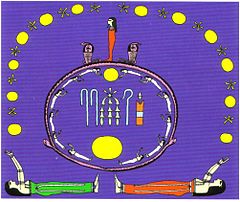Day (ancient egypt)
| Tag in hieroglyphics | |||
|---|---|---|---|
| Old empire |
Re Rˁ day |
||
| The ancient Egyptian day began with sunrise. | |||
A day in ancient Egypt corresponded to 24 ancient Egyptian hours, which were divided into “twelve hours of the day” and “ twelve hours of night ”. The twelve hours of the day usually began with sunrise and lasted until sunset, followed by the twelve hours of night. The visible sun thus marked the bright day . The date in the Egyptian calendar did not change to midnight as in the Gregorian and Julian calendars , but with sunrise.
The first day of the month in the ancient Egyptian lunar calendar began on the day of the disappearance of the old light - crescent moon at dawn before sunrise. Since the last hours of the night belonged to the old day , the invisibility of the moon was a reliable signal transmitter immediately before the rising sun. When the moon is new , it is not possible to see a crescent moon, as the moon rises almost simultaneously with the sun without the crescent moon formation and the new light moon cannot be seen with the naked eye.
The ancient Egyptian day always dated over a period of two Julian or Gregorian days. Heliac rising stars always belonged to the old day , which is why they are to be dated back one day in the Julian or Gregorian calendar. For example, if Sirius, as a signaling device for the flood of the Nile , had its heliacal rise on June 20th, this event still counted on June 19th in the ancient Egyptian calendar. The arrangements of the diagonal star clocks and the entries in the groove book are based on this definition . There all visible deans are subdivided into the phases of acronychic culmination , acronychic decline and heliacal rise and assigned to an ancient Egyptian day: " One dean dies (acronic fall) and another lives (heliacal rise) at the beginning of a decade ."
Definition of the ancient Egyptian day
The Egyptian calendar was divided into 36 weeks, each consisting of ten days. The beginning of each week was based on the Dean's Day , the beginning of which was determined by the heliacal rise of the relevant Dean's Star . The Egyptians called the last five days of the year Heriu-renpet ( Epagomene ).
In the past there have been controversial discussions in Egyptology about the time of the beginning of an ancient Egyptian day. Due to unclear statements in sources that can be attributed to ancient Egyptian mythology , some Egyptologists counted dawn and dusk to the 12 hours of the day. In contrast, the 12 hours of the day in the texts of ancient Egyptian astronomy are defined in relation to the ancient Egyptian calendar from sunrise to sunset .
The definitions made by the Egyptologists in older literature partly contradict one another. It can therefore happen that the literature of those Egyptologists is used as the basis for the definition of the beginning of the day from twilight, who at the same time defines the day from sunrise in another place. For example Richard Anthony Parker and Otto Neugebauer explain :
"The first hour of the night begins with darkness after sunset and no star is necessary to indicate it (the 1st hour of the night ) ... The heliacal rise was of decisive importance for the selection of the dean's stars, because the dean marks the 12th hour of the night ."
In the meantime, the technically greatly improved astronomical calculation options and the appearance of new text sources led to re-evaluations of historical texts in Egyptology and to corrections of incorrect statements in the older literature. Egyptologists and astronomers unanimously confirm that instead of the " invisible 70 days of Sirius " mentioned in the ancient Egyptian sources, 74 days can be recorded astronomically at the observation site Memphis in the early dynastic period ; in the further course of ancient Egyptian history, falling to 70 days in the 12th dynasty . This finding also contradicts the equation of the 1st and 12th hour of the day with the twilight phases, which, moreover , could not be recorded with the ancient Egyptian sundial due to the lack of shadow. The 12 hours of the day on the ancient Egyptian sundial therefore referred to the clear day.
Mythological definition
In ancient Egyptian mythology, the division of the twilight hours is a peculiarity that is documented, among other things, in the hourly calendar of Ramses II . The explanations of the Nutbuch representations in the grave of Seti I ( KV17 ) in the Valley of the Kings also describe this special situation: “The places of the first two hours of the night are the hands and lips of the sky goddess Nut ”. The entry of Re into the Duat takes place at the same time as the "swallowing of the Re". The transformation of the "Re in Heliopolis as the sun of the day" into the evening manifestation of the Atum vividly depicts the special situation of the "interim period of Re".
In this respect, the first two hours of the night in Egyptian mythology could still be counted as day, since the "hours of the night" originally began with the "swallowing of the Re". This view was synonymous for the last two hours of the night, when Re left the duat in the “birth process” but had not yet reached the horizon and appeared as dawn in the form of the deity Chepri .
Calendar definition
Day
In the calendar calculation, the principle of sun visibility was used consistently. The term day is associated with the appearance of the sun god Re. That is why the Egyptians called "every day" also "every sun". In the " Zweibrüdermärchen " the beginning of the day is described: "When the earth was bright for the next day". The “getting light” still referred to dawn , which also marked the twelfth hour of the night. Accordingly, the time after sunset was considered to be “the second half of the day, the darkness that follows Re”.
Christian Leitz describes the statement by Richard-Anthony Parker and Otto Neugebauer " The first hour of the day begins with twilight " as "unacceptable", as it contradicts the ancient Egyptian sources. There, for example in the groove book and in the diagonal star clocks, the heliacal rise is consistently scheduled at the 12th hour of the night. In addition, the acronychic sets and culminations at dusk count as entry into the duat , which takes place in the first hour of the night.
On the naos of the decades of Nektanebo I , the effectiveness of the deans begins with the culmination at the end of the 12th hour of the night. In this context, Alexandra von Lieven refers to the function of dawn, which is to be seen as the “birth phase of the sun god”, with Re still below the horizon. The dean's stars are named in the same way , “those who are“ born ”in the 12th hour of the night during dawn and are located above the“ exit gates of the duat ”.

In ancient Egyptian mythology, the beginning of the first hour of the day is also described as the "moment when the sun god Re leaves the area of the Mesqet and the Duat". In the original version of the Nutbuch it goes on to say:
"This is how [the command] arises that he (Re) withdraws to heaven, in the" hour that satisfies ". So his figure becomes strong and tall. At night the (dean's stars as) bas emerge in the sky while driving. The dean stars follow Re as he rises in the "hour that satisfies". During the day they are not visible to people. "
The times of day were represented by the goddesses of the hours in ancient Egypt . Richard-Anthony Parker and Otto Neugebauer “ postulated ” that “the hour that satisfies” is otherwise not verifiable in ancient Egyptian texts. Since the “hour that satisfies” belongs to the day, it is actually unknown in the “Book of Night”, but it is documented in the “Book of the Day”: “The majesty of this God emerges in the hour that makes the beauty of Re appear . This is the hour that satisfies ”. In addition, this hour is mentioned two more times with regard to the course of the sun in the “book of walking through eternity”. The Carlsberg 1 papyrus, which was not created until the Greco-Roman period , is a copy of the original groove book versions from the New Kingdom . The Carlsberg 1 papyrus contains numerous new theological interpretations.
“Re commands his removal from the people in the Duat, in the ninth hour of the night, that is, in the“ hour that satisfies ”. The dean's stars make their migration while pulling in the sky. Their entrances are invisible to the human face. His (re) looking to the earth when it rises is its rays. "
The commentator on Papyrus Carlsberg 1 has obviously confused the allocation of the "hour that satisfies", since he equated it with "the ninth hour of the night", even though it is the first hour of the day. The rise of the dean's stars, which “move across the sky with Re”, now takes place during the day due to the shifting of the sunrise to the ninth hour of the night, which is why their rise can no longer be observed.
The newly compiled statements show the commentator's difficulty in understanding the meaning; for example why the sun moves away in the "ninth hour of the night", although people cannot see the sun anyway. The incorrect assignments clearly demonstrate the fact that the "lesson that satisfies" was a carryover from other texts that the commentator no longer had. He therefore came to erroneous "conclusions", some of which even contradict the statements made in the chapter on the dean's stars in the Carlsberg 1 papyrus.
night
The night began with dusk immediately after sunset in the 12th hour of the day and ended with sunrise. The end of the twelfth hour of the night also marked the end of the Egyptian day. The arrangement of the deans on the diagonal star clocks contradicts the hypothesis that the first hour of the night does not start until after dusk. A dean was basically the “signal” and “namesake” for a period of 10 days.
The stars belonging to a dean had a much lower brightness than Sirius, which is why, under normal conditions, those stars only became visible about 50 to 60 minutes after sunset and immediately afterwards either culminated or set acronymously . The corresponding statements about the “death of a dean” in his acronymic downfall always referred to the first hour of the night. The dean stars representing the dean therefore always indicated the end of the first night period, which was followed a short time later by the beginning of the second night period.
“What is between the star that makes the 1st hour (of the night) (culmination), that is, the star of the evening, to the one that orbits the Duat (acronymic setting), that is 9 stars ... The majesty of this God's (Re) enters (into the Duat) with regard to the 1st hour (the dean's stars) in the darkness ... The majesty of this God (Re) goes to rest ... into the Duat in the 2nd hour of the night. "
In the "Book of the Night" which begins Barken -Nachfahrt of Re also in the second hour of the night, while Seth is at the "shore of the lake," over which the dying Dean (the first hour of the night) is still pending and lightly touched him. The sun god Re can only enter his boat if he has passed the “Gate of the All-Eater (Seth)” undamaged at the beginning of the second hour of the night. A night hour was 50 minutes on the longest day of the year and 70 minutes on the shortest anniversary. From the time of sunset to the end of astronomical twilight , around 90 minutes pass on average in Egypt, so that the phase of total darkness always fell in the second hour of the night.
In the “Zweibrüdermärchen” after sunset, the previous day is spoken of as “yesterday” and as “time that does not belong to Re”. The nights at ancient Egyptian festivals always fall on the day before, even if the festival begins in the time immediately after sunrise. The " Ancient Egyptian New Year " also began "on the night of the fifth day of the Heriu-renpet season". With the first rays of the sun from the first Achet I , the new year arrived a short time later, whereby the "birth of Re" had the beginning in the old year and was completed in the new year at the time of sunrise. Sopdet could therefore also function as a "midwife" during the dawn as the manifestation of Isis or Hathor .
Day lengths
The length of a day or night hour fluctuated on average between 1 hour 9 minutes and 51 minutes depending on the season . The average day and night lengths had a range of 10 hours 21 minutes (December 21/22) to 13 hours 44 minutes (June 21/22).
The times mentioned apply to the observation site Memphis . The values change depending on the latitude, with the twilight phases increasing in length to the north and decreasing in length in the south.
| Duration of twilight, day and night in Memphis | ||||
| Light state | 20./21. March | 21./22. June | 22./23. Sep | 21./22. Dec |
|---|---|---|---|---|
| Astronomical twilight | 04:39 am | 03:22 am | 04:24 am | 05:21 am |
| Nautical twilight | 05:07 am | 3:55 a.m. | 4:52 am | 05:51 am |
| Civil twilight | 05:35 am | 04:29 am | 5:20 am | 6:21 am |
| sunrise | 6:00 a.m. | 04:55 am | 05:44 am | 06:47 am |
| sunset | 6:03 pm | 6:56 pm | 5:47 pm | 4:56 pm |
| Civil twilight | 6:07 pm | 7:00 p.m. | 5:51 pm | 17:00 o'clock |
| Nautical twilight | 6:31 pm | 7:27 pm | 6:15 pm | 5:27 pm |
| Astronomical twilight | 6:59 pm | 8:00 p.m. | 6:43 pm | 5:57 pm |
| Night duration (total darkness) | 7:27 pm - 4:38 am | 8:36 pm - 3:21 am | 7:11 PM - 4:23 AM | 6:25 pm - 5:20 am |
| Day duration (light day) | 06:00 am - 06:03 pm | 04:55 am - 6:56 pm | 05:44 am - 5:47 pm | 06:47 am - 04:56 pm |
literature
- Rolf Krauss : Sothis and moon dates: studies on the astronomical and technical chronology of ancient Egypt . Gerstenberg, Hildesheim 1985, ISBN 3-8067-8086-X .
- Christian Leitz : Studies on Egyptian Astronomy . Harrassowitz, Wiesbaden 1991, ISBN 3-447-03157-3 .
- Christian Leitz: Ancient Egyptian star clocks . Peeters, Leuven 1995, ISBN 90-6831-669-9 .
- Ulrich Luft: The beginning of the day in Egypt: The day began at sunrise . In: Ancient Near Eastern Research . (AoF) No. 14. Academy, Münster 1987, pp. 3-11.
- Jean Meeus : Astronomical Algorithms - Applications for Ephemeris Tool 4, 5th 2nd edition. Barth, Leipzig / Berlin / Heidelberg 2000, ISBN 3-335-00400-0 .
- Jean Meeus: Astronomical Tables of the Sun, Moon and Planets . 2nd Edition. Willmann-Bell, Richmond 1995, ISBN 0-943396-02-6
- Richard Anthony Parker , Otto Neugebauer : Egyptian Astronomical Texts. (EAT), Vol. I. Brown University Press, Rhode Island 1969.
- Siegfried Schott: Ancient Egyptian festival dates . Publishing house of the Academy of Sciences and Literature, Mainz / Wiesbaden 1950.
- Alexandra von Lieven : Floor plan of the course of the stars - the so-called groove book . The Carsten Niebuhr Institute of Ancient Eastern Studies (among others), Copenhagen 2007, ISBN 978-87-635-0406-5 .
- Alexandra von Lieven: The sky over Esna - A case study on religious astronomy in Egypt using the example of the cosmological ceiling and architrave inscriptions in the temple of Esna . Harrassowitz, Wiesbaden 2000, ISBN 3-447-04324-5 .
Individual evidence
- ^ Siegfried Schott: Ancient Egyptian festival dates . P. 20.
- ↑ a b Alexandra von Lieven: Plan of the course of the stars . Pp. 69-73.
- ↑ a b Christian Leitz: Ancient Egyptian star clocks . P. 72.
- ↑ In Elephantine , Sirius was invisible for 63 days. For the whole of Egypt the average was 69 days; see. also Rolf Krauss: Sothis and moon dates . P. 61.
- ↑ a b c d Alexandra von Lieven: Plan of the course of the stars . Pp. 136-140.
- ↑ a b Alexandra von Lieven: Plan of the course of the stars . Pp. 55-57.
- ^ Richard Anthony Parker, Otto Neugebauer: Egyptian Astronomical Texts, Vol. 1 . P. 50.
- ↑ Christian Leitz: Ancient Egyptian star clocks . P. 73.
- ↑ Alexandra von Lieven: Plan of the course of the stars . P. 151.
- ↑ Values according to Southern Stars Systems SkyChart III , Saratoga, California 95070, United States of America.







